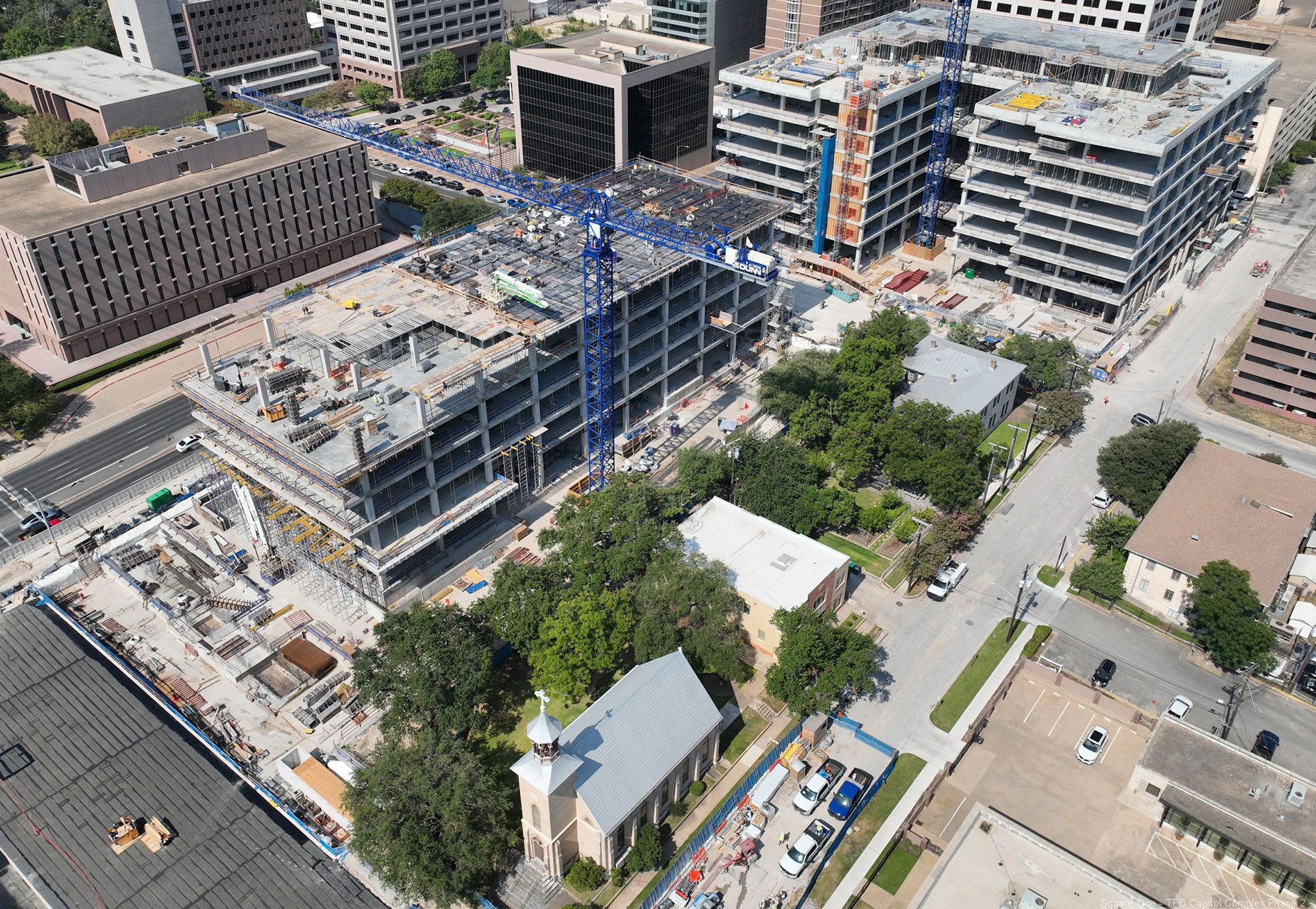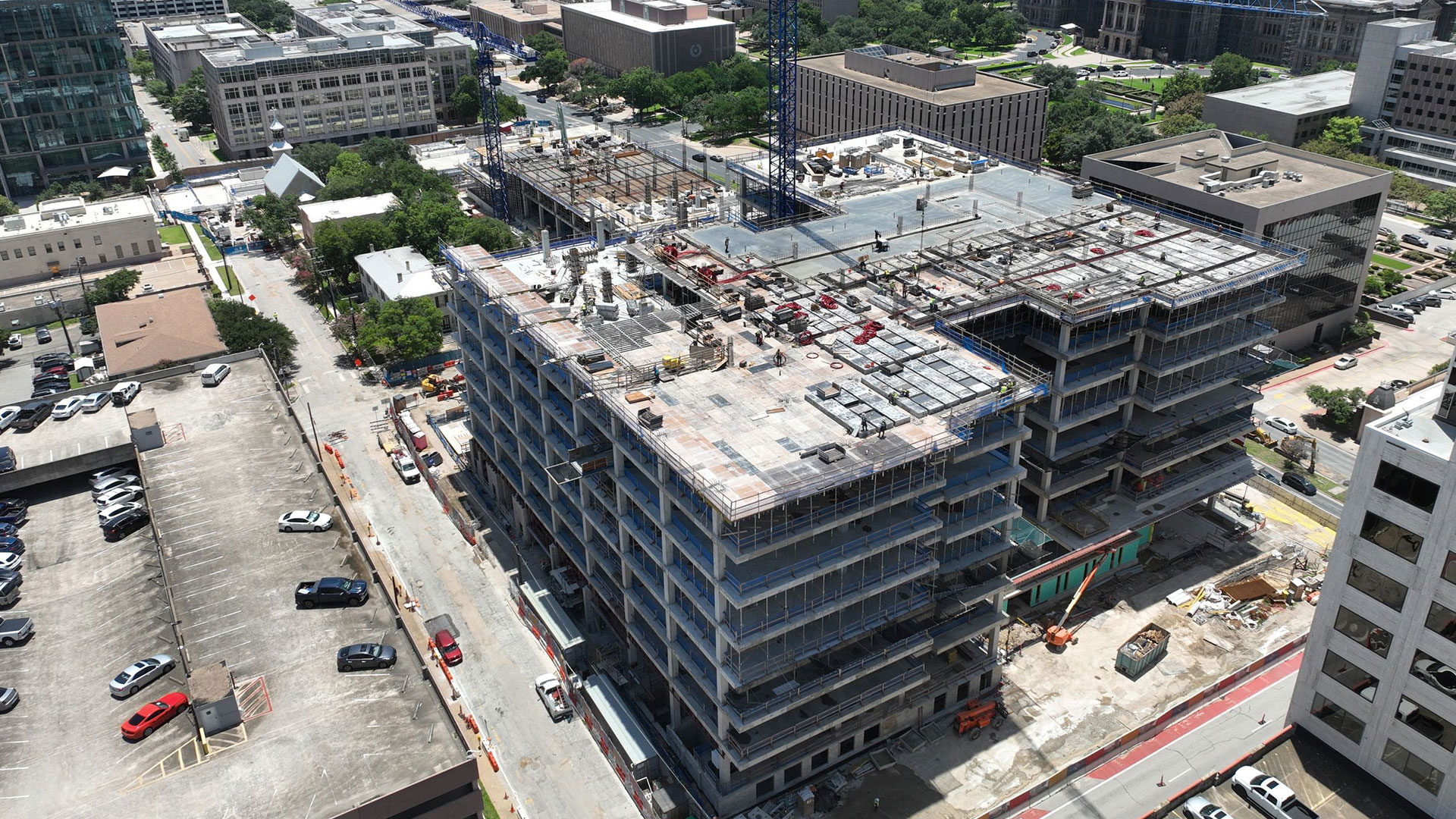Pictured above: Overview of Phase II of the Capitol Complex Project looking east. Photo courtesy of the Texas Facilities Commission.
Bringing power to a construction site as large as Phase II of the Capitol Complex Project is not as easy as flipping a switch. There are three phases to powering the project‒generator power, temporary power, and permanent power. Since October 2024, onsite generators have provided electricity to power the project cranes. It has taken months of planning and coordination between General Contractor JE Dunn, electrical trade partner Tumlinson Electric, LLC, the Texas Facilities Commission, Austin Energy, and the City of Austin to bring temporary power to the site. During this time, the concrete decks for the parking levels of the 1501 Lavaca State Office Building were completed, and concrete pours continue on the upper levels of the building and the below-ground parking levels of the 1500 Congress State Office Building and the Texas Capitol Mall Extension. Other trade contractors are now arriving on the site to finish the lower and upper levels as they are poured. The temporary power will provide electricity for the various tools and equipment the trade contractors use to complete the project.
Planning and Permitting
JE Dunn’s first step in bringing temporary power to the site was completing Austin Energy’s Electric Service Planning Application (ESPA). The application walked the project team through the amount of power a project the size of the Capitol Complex Project Phase II will need at the peak of the construction phase. The team calculated the project’s power needs based on the variety of equipment required, including tower cranes, buck hoist material lifts, placing booms, and the number of amps per floor that the trade contractors will use to charge or run their equipment. Using the ESPA, Austin Energy analyzed the best way to provide the electricity needed and designed the routing plans for the project team.
The electrical grid surrounding the project is all underground. Therefore, JE Dunn had to request traffic control permits from the City of Austin to work in the streets and right-of-way and shut down traffic lanes, as necessary.
Delivering Power to the Site
Starting at the power source, a project crew tied into the line and ran a duct bank, an underground grouping of conduit, to the manhole depicted on the plans. Duct banks allow Austin Energy to feed electric cables through the underground infrastructure network. From the manhole, the crew ran conduit onto the project site to the pad-mounted transformer locations for both the 1501 Lavaca and 1500 Congress sites. At this point, the crews brought the conduit above ground and stubbed it out. Careful placement of the conduit stub-outs per the Austin Energy plans was necessary for the transformer connections.
With the conduit completed, the project team repaired the streets and right-of-way. The City of Austin inspected the repairs and Austin Energy inspected the duct banks and electrical infrastructure.

A crane setting a transformer in place on Phase II of the Capitol Complex Project. Photo courtesy of JE Dunn.
While project crews repaired the streets and right-of-way, another project crew poured the concrete pad around the stubbed-out conduit to hold the transformers. Once the concrete cured (dried), Austin Energy delivered the transformers to the site and set them in place using a crane.
There are two compartments to a transformer, the primary is where the power comes in, and the secondary is where the power exits the transformer and connects to the site. Austin Energy ran the feeder lines through the conduit and connected them to the primary compartment of the transformers. From there, Tumlinson Electric, LLC, ran conduit with feeder lines from the secondary compartment of the transformers to temporary skids with power panels. Lines from the power panels were connected to smaller, mobile power units, distributing power to the various areas on the sites, including the tower cranes.

A temporary skid with power panels.
Photo courtesy of JE Dunn.
When everything was connected, the City of Austin’s electrical inspector checked the onsite systems and gave the sites “green tags.” Green tags verify that the systems are safe and installed properly. Austin Energy then performed meter inspections to confirm that the systems would correctly read the amount of current used. After these inspections, the meters were set, and Austin Energy energized the transformers for both sites.
The Texas Facilities Commission would like to thank the project team, Austin Energy, and the City of Austin for their expertise in achieving this important milestone for Phase II of the Capitol Complex Project.

Mobile power units connect to the power panels on the temporary skid and distribute power throughout the site.

An Austin Energy employee in protective gear energizes the transformer. Photos courtesy of JE Dunn.



